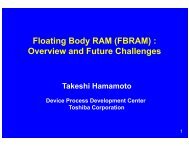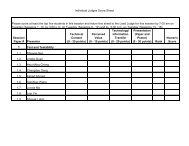Vertically Integrated Test/Calibration and Reliability Enhancement ...
Vertically Integrated Test/Calibration and Reliability Enhancement ...
Vertically Integrated Test/Calibration and Reliability Enhancement ...
Create successful ePaper yourself
Turn your PDF publications into a flip-book with our unique Google optimized e-Paper software.
<strong>Vertically</strong> <strong>Integrated</strong><br />
<strong>Test</strong>/<strong>Calibration</strong> <strong>and</strong> <strong>Reliability</strong><br />
<strong>Enhancement</strong> for Systems with<br />
RF/Analog Content<br />
Sule Ozev<br />
Sule.ozev@asu.edu<br />
(480) 727 7547<br />
Arizona State University<br />
School of Electrical, Computer, <strong>and</strong><br />
Energy Engineering<br />
1
Outline<br />
• Trends <strong>and</strong> challenges they bring<br />
• Post production calibration with a global<br />
view<br />
• Defect-based screening<br />
• <strong>Reliability</strong> modeling issues <strong>and</strong> reliability<br />
enhancement<br />
• Vision<br />
2
Trends<br />
• Integration of digital, analog, RF<br />
subsystems<br />
• Increasing process variations<br />
• Increasing defect rates<br />
• Reducing mean-time-to-failure<br />
• Continuous optimization of processes for<br />
digital performance<br />
• Increasing digital processing capability<br />
3
Challenges for Analog/RF Circuits<br />
• Process variations introduce uncertainty into<br />
performance<br />
– Post-production calibration is necessary not just of<br />
high-resolution operations, but for all functionalities<br />
• Increasing defectivity requires defect-based<br />
screening techniques<br />
– Screening techniques need to be analyzed in terms of<br />
defect coverage<br />
• Continuous process optimization<br />
– Learned behavior <strong>and</strong>/or correlations need to be<br />
revised through product lifetime<br />
• Reducing lifetime<br />
– Analog/RF subsystems may become single points of<br />
failure 4
Post-production <strong>Calibration</strong><br />
• Analog designers have been dealing with process<br />
variations<br />
– Many specific techniques exist to calibrate<br />
performance to within specifications<br />
• ADCs, PLLs<br />
– Few generally applicable techniques exist<br />
• Bias tuning with bias banks or DC voltage control<br />
• Bias tuning with negative feedback<br />
• Frequency tuning with banks of passive devices or voltage<br />
controlled passives<br />
• Adjustment of matching networks with capacitor tuning<br />
• Adjustment of transistor width<br />
• Trade-offs almost always exist<br />
– Tuning for one performance parameter may degrade<br />
another one<br />
– e.g. gain vs. linearity or linearity vs. power<br />
consumption<br />
5
<strong>Calibration</strong> in the Context of<br />
Complex Systems<br />
• System is made up of many blocks,<br />
compensation effects need to be taken<br />
into account<br />
Block X<br />
Block Y<br />
G Y_min = 9dB<br />
G Y_max =11dB<br />
G X_min = 9dB<br />
G X_max =11dB<br />
G min =18dB<br />
G max =22dB<br />
G Y =7dB<br />
G X =11dB<br />
G=18dB<br />
• Local calibration may not always produce<br />
optimum results<br />
G Y =7dB<br />
G X=10dB<br />
G=17dB<br />
G Y =8dB<br />
G X =10dB<br />
G=18dB<br />
G Y =7dB<br />
G X =11dB<br />
G=18dB<br />
6
Digital Processing<br />
• With millions of transistors available, digital<br />
processing capability increases<br />
• Digital compensation becomes more affordable<br />
• Examples of digital compensation exist<br />
– e.g. pipelined ADCs<br />
– e.g. Compensation of IQ mismatch in transceivers<br />
• Well, it is not free!<br />
– Processing capability is there but it most certainly has<br />
other uses<br />
• Computational overhead of compensation<br />
– Digital circuits are slow<br />
• Latency of compensation<br />
– Any additional operation adds power consumption<br />
• Yet another power/performance trade-off<br />
7
<strong>Calibration</strong> in the Context of<br />
Complex Systems<br />
• Local calibration needs to work in<br />
conjunction with system-level optimization<br />
– Trade-offs of each calibration scheme<br />
– Trade-offs at the system level<br />
– Trade-offs <strong>and</strong> limits of digital compensation<br />
– Optimization process that decides what level<br />
of calibration <strong>and</strong>/or compensation<br />
8
Increasing Defectivity<br />
• Use of high-end digital processes for<br />
analog/RF circuits introduces higher<br />
defectivity<br />
– Hard defects<br />
– Parametric deviations beyond process<br />
tolerance<br />
9
Defect Manifestation<br />
Defects<br />
Physical<br />
Phenomena<br />
Catastrophic<br />
Faults<br />
Parametric<br />
Faults<br />
Circuit<br />
Manifestations<br />
Specification<br />
Violation<br />
Acceptable<br />
Specifications<br />
Effect on<br />
Specifications<br />
• Most physical defects will result in complete loss of<br />
functionality<br />
– e.g. most open-circuit or short circuit defects that fall in the<br />
signal path<br />
• Some defects result in a shift in the overall behavior<br />
– e.g. broken finger of a transistor<br />
– e.g. inductor coil shorts
How do defects affect the test<br />
process<br />
• Traditional specification-based testing<br />
– If all specifications are measured, then there is no problem<br />
with initial quality<br />
– Almost certainly will not be the case<br />
– <strong>Test</strong> selection is typically y based on learned statistical<br />
information<br />
– Defective circuits do not follow the statistics<br />
– Defect-based selection techniques are needed<br />
• New techniques for testing<br />
– Techniques that rely on the measurement of correlated<br />
parameters (e.g. bias current, or DC voltages)<br />
– Techniques developed for BIST applications (e.g. sensorbased<br />
testing)<br />
– Techniques that rely on correlations among specifications<br />
(e.g. machine-learning i based testing) ti – … need to be evaluated for defect response 11
Continuous Process Optimization<br />
• Conclusions drawn from early samples<br />
(characterization data) may not be valid<br />
later on<br />
• Adaptive test/calibration techniques are<br />
needed<br />
– Re-learn through h process shifts<br />
– Mechanisms of learning need to be<br />
continuously refined<br />
12
<strong>Reliability</strong><br />
• Not much attention has been paid to<br />
analog/RF circuit reliability<br />
• Device reliability has been extensively<br />
studied<br />
– E.g. electromigration, oxide breakdown<br />
– Some research still needed for other analog<br />
components (inductors, capacitors)<br />
• Existing i aging models are generally based<br />
on digital circuits<br />
13
Analog Circuit Wearout vs. Digital<br />
Circuit Wearout<br />
• Using models <strong>and</strong> techniques from the<br />
digital domain is a start<br />
• However, wearout patterns may be<br />
significantly different<br />
– constant t bias vs. smaller stress on Vgs<br />
• Does this suggest electromigration is more of an<br />
issue than oxide breakdown?<br />
– Wearout is not uniform<br />
• e.g. RF choke in a power amplifier vs. input<br />
inductor in an LNA<br />
14
Analog/RF <strong>Reliability</strong><br />
• Wearout monitors are needed<br />
– Local monitors<br />
• Bottom-up approach<br />
• Duplicating the operating conditions on critical<br />
components may be too costly (area, power)<br />
• Diagnosis is easy but monitoring is hard<br />
– System-level monitors with local diagnosis<br />
• Top-down approach<br />
• Analog diagnosis is very challenging but possible<br />
• Monitoring i is easy but diagnosis i is challenging<br />
15
<strong>Reliability</strong> <strong>Enhancement</strong><br />
• H<strong>and</strong>le degradation in performance at the<br />
system level (compensation)<br />
• Re-calibrate at the circuit-level<br />
• Replace degraded unit<br />
• Same issues?<br />
16
Re-calibrating for <strong>Reliability</strong><br />
<strong>Enhancement</strong><br />
• Can we use the same post-production<br />
p<br />
calibration schemes?<br />
• Sometimes, but not always<br />
– <strong>Calibration</strong> schemes may be counter-productive<br />
ti<br />
for reliability<br />
– e.g. LNA<br />
• Degradation of inductor reduced gain increase<br />
bias current faster degradation<br />
• Need to perform system-level trade-off<br />
analysis<br />
– e.g. can we off-load some of the work of the<br />
degraded building block to another building<br />
block?<br />
17
Replacement/Reconfiguration<br />
• If degradation is beyond a certain level,<br />
replacement is needed<br />
• Replacement of complete functionality is<br />
optimal from performance perspective<br />
– e.g. replace the complete receiver chain<br />
– But, costly in terms of hardware<br />
• Replacement at the lower levels is<br />
possible<br />
– Loading, noise injection<br />
– How to turn off the component not being<br />
used?<br />
18
Vision<br />
• Research is needed at multiple levels of<br />
hierarchy<br />
– Circuit-level calibration<br />
– System-level compensation using digital<br />
computation<br />
ti<br />
– Defect-based testing <strong>and</strong> test evaluation<br />
– <strong>Reliability</strong> monitoring<br />
– <strong>Reliability</strong> enhancement<br />
– Re-configuration<br />
– Global optimization that takes all trade-offs into<br />
account<br />
19








